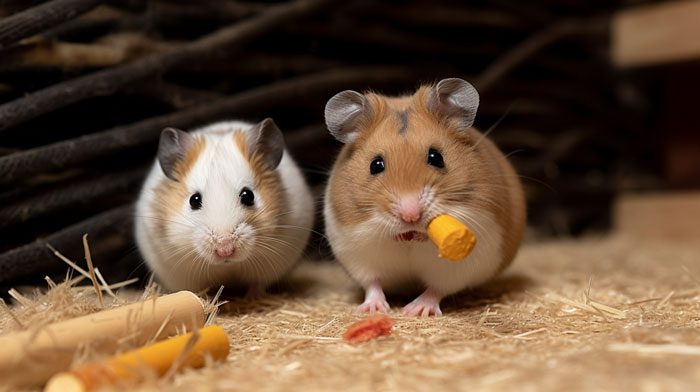How Big should a Hamster Cage be? Explore Everything
As an animal lover, you want to make sure your furry friends have the best possible living conditions. When it comes to hamsters, one of the most important things to consider is the size of their cage.
However, how big should a hamster cage be? It depends on many things. But in general, 24 inches long, 12 inches wide, and 12 inches tall can be a minimum cage measurement.
We will provide you with all the information you need to know about the appropriate size of a hamster cage. So you can give your pet the space they need to live happily and healthily.
Hamster Cage Size: A Crystal-Clear Answer
The minimum size for a hamster cage should be at least 24 inches long, 12 inches wide, and 12 inches tall, as mentioned before. However, this is only the minimum size, and it’s highly recommended to provide a larger living space for your pet friend.

Ideally, the cage can be 30 inches long, 20 inches wide, and 18 inches tall. It will give your hamster plenty of room to move around, exercise, and explore. As a result, it won’t feel stressed or bored.
Why is Cage Size So Important for Hamsters?
With hamsters, the cage size is significant. Moreover, a large-sized cage is advised. Our conversation will be divided into two parts: the need for a large cage and why tiny cages shouldn’t be utilized.

1. Why Big size Cage is Recommended?
- Hamsters are active creatures that require plenty of exercise to stay healthy and happy.
- Providing your hamster with a spacious cage that allows for plenty of movement and exercise is crucial to its well-being.
- In addition to the floor space, a suitable cage should also provide plenty of hiding spots, toys, and a suitable substrate for burrowing and digging.
- Some species, such as Syrian hamsters require a minimum of 450 square inches of floor space.
- Make sure your hamster has an appropriate cage size and plenty of opportunities for exercise and play. So that it remains happy and healthy in its home.
2. Why Small size Cage should be avoided?
- A cage that is too small can lead to stress, anxiety, and depression in hamsters.
- Small cages can also lead to health problems such as obesity and muscle atrophy.
- These health problems can shorten your hamster’s lifespan and reduce its overall quality of life.
- It’s important to consider the number of hamsters you have when selecting a cage size, as multiple hamsters will require more space.
- A cage that is too large, however, can be difficult to maintain and may not provide a sense of security for your hamster.
Hamster Cage: Factors to Consider When Buying
When choosing a hamster cage size, there are a few factors you should consider.

Decide on the cage measurement
First, think about the size of your hamster. We have said it before, different species of hamsters may require different spaces. Dwarf hamsters are smaller and will need less space than larger breeds, such as Syrian hamsters.
Wisely think of the cage location
Choosing the right location for your hamster’s cage is important for their well-being. Consider a quiet, temperature-controlled area with good ventilation and easy access for daily care. Avoid high-traffic areas and potential predators for your hamster’s safety and security.
Consider the number of hamsters
Also, consider the number of hamsters you plan to keep in the cage. If you have multiple hamsters, you’ll need a larger cage to accommodate all of them. That means if you have plenty of pet animals, you will need larger space.

Type of activity matters
Another factor to consider is the type of activities you want to provide for your hamster. If you plan to give your pet lots of toys, tunnels, and other accessories, you’ll need a larger cage to accommodate them all.
Which Cage will be the Best for a Hamster?
Knowing which cage is better for hamsters in terms of size is also an important matter. As per experts, wire cages and plastic cages are the types your hamster likes.
Although some may say glass cages are good, they may not be the best choice. Because of less ventilation, I don’t recommend glass cages.

However, let’s see the differences between these cages.
| Features | Wire Cages | Plastic Cages |
|---|---|---|
| Durability | More durable and lasts long | Less durable and may crack or scratch over time |
| Ventilation | Offers more ventilation and air circulation | May have less ventilation and more confined air circulation |
| Cleaning | Easier to clean | Plastic materials may require more efforts |
| Homemade | Can be made at home but special equipment and skills are needed | Homemade and very easy to make |
| Chewing | Wire material can withstand chewing and gnawing | Plastic material can be chewed and destroyed by a hamster |
| Visibility | Offers a clear view of the hamster and its activities | Maybe provide less visibility of the hamster |
| Noise | Can be noisier due to the metal material | May provide a quieter environment due to the plastic material |
| Customization | Can be more customizable with accessories and attachments | May have limited customization options due to the plastic material |
| Cost | Can be up to $40 | Can be up to $10 |
These are some common parameters based on what I showed in comparison. You might have some other things to consider as well. Please be known of all these and then decide which one you would buy.

FAQs
Keep reading to find out a little bit more.
Q: Do hamsters need a wheel in their cage?
Yes, a wheel is an essential item for a hamster’s cage as it provides them with exercise and mental stimulation. However, it’s important to choose an appropriately sized wheel for your hamster and ensure it’s safe and stable for them to use.
Q: Which hamster species particularly require a big cage?
According to some statistics, Syrian hamsters require the largest cage. It’s a 24-inch by 12 inches and 12-inch cage that might be the most suitable cage for a Syrian hamster.
Q: What kind of bedding should I use in my hamster’s cage?
There are a variety of bedding options available for hamster cages, including wood shavings and paper-based bedding. It’s important to choose bedding that is safe and absorbent and to avoid any types of bedding that could be harmful to your hamster’s health.
Final Thoughts
All in all, the minimum size of a hamster cage should be 24 inches long, 12 inches wide, and 12 inches tall. But this is not exactly how big should a hamster cage be. It’s highly recommended to provide a larger living space.
A large-sized cage allows your hamster to move around, exercise, and explore, which is crucial to its happiness and health. In summary, choose the right cage size and type based on your hamster’s size and species, location, and desired activities.




